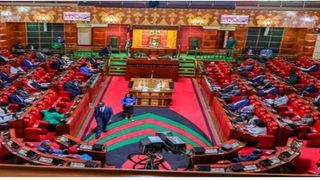
The National Assembly in session in November 2018. The office that advises Parliament on budget matters has issued a warning regarding the amount of money that is being used to service public debt.
Business
Premium
Inside Kenya’s debt hole: Worry as debt service bill expands
What you need to know:
- The government plans to borrow at least Sh718 billion to plug the budget deficit during current fiscal year.
- Money used to repay loans on verge of overtaking national, county spending combined.
Money being spent to service public debt is on the verge of surpassing the sum of the entire national government spending and all the 47 counties’ equitable share of revenues, as the impact of mounting debt pressures and a falling shilling worsen.
In the first three months of the current financial year, a total of Sh347.2 billion was allocated towards public debt service.
During the same period, the allocation for spending across the entire national government was Sh299.7 billion, with counties receiving Sh61.1 billion for equitable share, totalling Sh360.8 billion.
This meant that the spending on debt service was just Sh13 billion shy of the money spent across the entire national government, and the money issued to all the counties as equitable share, for the first quarter of 2023/24 financial year.
This is a sharp rise in the money the government is spending to service public debt as it faces a $2 billion (Sh253 billion) Eurobond debt that will be maturing in June next year, amid a sharp depreciation of the shilling, which has shed 24 per cent of its value against the US Dollar this year alone.
The Parliamentary Budget Office (PBO), in its July-September 2023 economic and fiscal update, notes that budgetary allocations to the Consolidated Fund Services (CFS)—the account through which the public debt is serviced—accounted for 51.6 per cent of all the money released for spending by the government, “surpassing resources availed for recurrent, development and county transfers combined.”
“Consolidated Fund Services (CFS) constituted the largest expenditure amounting to Sh384.9 billion for the July-September period. Main mover of CFS continue to be public debt servicing that amounted to Sh347.2 billion and accounting for 19.8 per cent of Sh1.75 trillion debt servicing expenditures expected for the rest of the fiscal year,” the PBO noted.
With the forecast spending on public debt for the remaining part of the financial year to June 2024 still significant at over Sh1.4 trillion, the budget watchdog observes that the National Treasury may have to explore options to reduce the debt-service burden, lest it leaves the country’s forex reserves badly depleted.
The Sh384.9 billion allocated to the CFS during the three months was a 45 per cent increase from the Sh264.8 billion allocated during a similar quarter last year.
The heavy spending on debt service, the PBO notes, has come at a cost to service delivery, with several MDAs not receiving money to fund development projects for the entire three months to end of September, as priority was given to paying salaries.
The allocation was also as the public debt stock hit Sh10.5 trillion by end of August, following a Sh1.6 trillion increase in the year to June 2023, mainly on account of depreciation of the shilling, which largely raised external debts.
“This was driven by a Sh1.62 trillion increase in public debt between June 2022 and June 2023, the highest increase in Kenya’s public debt on record. Domestic debt stock increased by Sh503.02 billion while external debt increased by Sh1.12 trillion partly due to the impact of the exchange rate on both new borrowing and external debt stock,” the PBO noted.
The shilling lost 23 per cent to the US Dollar and 33 per cent to the Euro between September 2022 and September 2023, both of which account for Sh5 trillion public debt by August (87.6 percent of the external debt).
The government plans to borrow at least Sh718 billion to plug the budget deficit during the current financial year, facing high interest rates from external markets and an apathy on long-term borrowing in the domestic market, as investors prefer short-term papers which are comparatively more rewarding.
“There are concerns on the effects of the liability management options available for the government regarding the maturing Eurobond. The authorities may opt to pay the June 2024 Eurobond maturity out of FX reserves. Repaying the entire $2 billion Jun 24 Euro-bond out of FX reserves may unnerve the market. Despite concerns about credit ratings, a buyback at par, or below par, is a viable option because it would imply willingness to pay. Alternatively, a blended strategy, that perhaps includes a partial buyback via an open tender and a smaller pay-out from FX reserves, may appear more reasonable,” the PBO advises.




